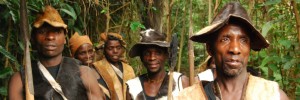Buniga Forest Walk: Involving the Batwa in Conservation

If you are ever curious as to why conservation organizations like IGCP are working to collaborate with the Batwa people of the region, all you have to do is watch one of their members set a snare for wildlife with not only expert precision, but with extreme satisfaction.
That's exactly what I watched Mr. Kapere Richard, a Mutwa guide do while experiencing the Buniga Forest Walk just prior to its being open for tourists on May 1st. It was with great joy that he demonstrated for us what he was taught by his grandfather, quickly setting snares designed to trap an animal's foot or neck, and even a snare for crushing the spine of a monkey. It sent a chill down my own spine!
Being able to demonstrate these skills is extremely important to the Batwa people and to the continuation of their culture because, unfortunately, their forest lifestyle is no longer possible. The forests of the Great Lakes region have diminished. Furthermore, the remaining biodiversity in protected areas in the region is unable to sustain the resource needs for a growing human population. This was the reason why the Batwa were made to leave the protected areas in the region not all that long ago in the early 1990s.
That recent history is another reason why IGCP is involved in projects that empower the Batwa people. Batwa communities are in transition- from life in the forest to life in permanent settlements outside of the forests. This transition is not an easy one and the Batwa are faced with many challenges as well as incidents of discrimination and exploitation by other community members. We owe them support during this transition and, what I am happy to report, we owe them a chance to preserve their rich culture in a way that benefits the forests and wildlife as well as the Batwa themselves.
What I experienced on the Buniga Forest Walk in Nkuringo near Bwindi Impenetrable National Park was magical. Not only is this forest fragment interesting, with its pockets of tree ferns and lobelia, it was something that I experienced along with the Batwa guides themselves and their families. There were surprises at every turn:
In short, the Buniga Forest Walk was fun for the Batwa guides, which made it all the more fun for me! IGCP has supported the development of a management plan for the 1 km2 Buniga Forest which is owned by the Kisoro Local Government, and through an agreement, is managed by the Nkuringo Community Conservation and Development Foundation (NCCDF) and has recently facilitated the training of guides and the development of the trail infrastructure. Now IGCP's responsibility is to create an identity for the trail, a brochure, and a website, so that tourists will know that the trail exists and have the chance to meet the Batwa in Buniga Forest as well as in their own community. All this in a way that is respectful, authentic, and overall a very enjoyable experience!